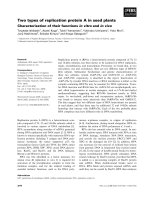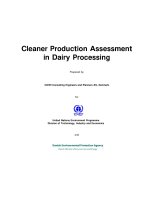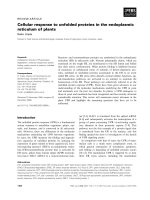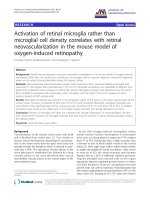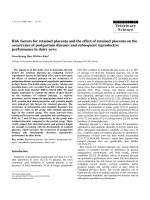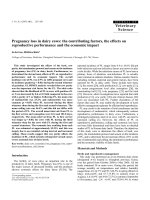Cellular energy supply and aging in dairy cows characterization of different physiological states and impact of diet induced over condition
Bạn đang xem bản rút gọn của tài liệu. Xem và tải ngay bản đầy đủ của tài liệu tại đây (1.98 MB, 108 trang )
Institut für Tierwissenschaften
Abteilung Physiologie und Hygiene
der Rheinischen Friedrich-Wilhelms-Universität Bonn
Cellular energy supply and aging in dairy cows:
Characterization of different physiological states and impact of diet-induced over-condition
Inaugural-Dissertation
zur
Erlangung des Grades
Doktor der Agrarwissenschaften
(Dr. agr.)
der
Landwirtschaftlichen Fakultät
der
Rheinischen Friedrich-Wilhelms-Universität Bonn
von
Dipl.-Ing. agr.
Lilian Laubenthal
aus
Köln
Referent:
Prof. Dr. Dr. Helga Sauerwein
Korreferent:
Prof. Dr. Karl-Heinz Südekum
Fachnahes Mitglied:
Prof. Dr. Karl Schellander
Tag der mündlichen Prüfung:
11.09.2015
Erscheinungsjahr:
2015
English abstract
Lactation in dairy cows is accompanied by dramatic changes in energy balance and thus requires the
continued adaption of the key organs, namely adipose tissue (AT), liver, and mammary gland to the
varying conditions. The supply of energy by mitochondria, the “powerhouses” of the cell, therefore is of
pivotal importance in dairy cows, because both the number of the mitochondria and the copy number of
their own genome, the mitochondrial DNA (mtDNA), can change according to different physiological,
physical and environmental stimuli. Moreover, determination of the length of telomeres, short repetitive
DNA sequences at the end of chromosomes, has become a common method in human research to
determine an individual’s physiological age. Due to the fact, that telomeres shorten with every cell
division and this shortening is influenced by diet, metabolic stress, and diseases, telomere length (TL) in
dairy cows might serve as a phenotypic biomarker for longevity. The aim of this dissertation was to
characterize the effects of lactation and the influences of a 15-weeks period of diet-induced over-condition
on mitochondrial biogenesis, variation of TL and on markers for oxidative stress in dairy cows.
Furthermore, as lipogenic and lipolytic processes during lactation result in changes of AT mass, we aimed
to investigate angiogenesis and hypoxia in AT after an excessive fat accumulation. The mtDNA content
and TL in blood as well as in AT, mammary gland, and liver of primiparous (PP) and multiparous (MP)
dairy cows were studied during early and late lactation. Furthermore, the expression of genes related to
mitochondrial biogenesis was measured in tissue samples of these cows as well as in AT of overconditioned, non-lactating dairy cows. The effects of over-condition on oxidative stress related changes in
mtDNA content in non-lactating cows were also examined. From early to late lactation, tissue mtDNA
copy numbers increased in all lactating cows in a tissue-specific manner, whereas blood mtDNA content
decreased during this period. The highest mtDNA content found in liver emphasizes the crucial metabolic
role of this organ in dairy cows. Also mRNA expression of mitochondrial biogenesis related genes
changed tissue-dependently, whereby the transcriptional regulation of mtDNA was limited to AT. Strong
correlations between blood and tissue mtDNA during early lactation were observed, suggesting blood
mtDNA measurements for indirectly assessing the energy status of tissues and thus substituting tissue
biopsies. Telomeres were only shortened in blood and mammary gland from early to late lactation and the
rate of shortening was dependent on the initial TL in all investigated samples. Due to diet-induced overcondition, the markers for oxidative stress increased in non-lactating cows, which might in turn impair
mtDNA. Furthermore, enlarged adipocytes showed signs of hypoxia, indicating insufficient angiogenesis
in AT. The ascending mtDNA content might improve the energy supply and thus compensate the hypoxic
condition in rapidly expanding AT. The results in the present dissertation provide a longitudinal
characterization of mtDNA content and mitochondrial biogenesis as well as TL in different tissues and in
blood from dairy cows during lactation. Therefore, this thesis serves as a basis for further studies
elucidating the role and regulation of mitochondria and telomeres in various pathophysiological conditions
in cattle.
German abstract
Die Laktation von Hochleistungskühen wird begleitet von beträchtlichen Veränderungen in der
Energiebilanz der Tiere. Die hauptsächlich an der Laktation beteiligten Organe, Fettgewebe, Leber und
Milchdrüse müssen sich daher kontinuierlich an die variierenden Bedingungen anpassen. Mitochondrien,
die „Kraftwerke“ der Zellen, sorgen für eine ausgewogene Energieversorgung und sind daher ein
wichtiger Bestandteil im Organismus von Milchkühen. Die Mitochondrienanzahl sowie die Kopienzahl
des mitochondrialen Genoms, die mitochondriale DNA (mtDNA), kann sich entsprechend
physiologischer, organischer und umweltbedingter Stimuli verändern. In den Humanwissenschaften ist die
Bestimmung der Telomerlängen (TL) eine gebräuchliche Methode, um das physiologische Alter eines
Individuums zu definieren. Telomere sind kurze, sich wiederholende DNA-Sequenzen an den
Chromosomenenden, die sich mit jeder Zellteilung verkürzen. Zusätzlich wird die TL-Verkürzung durch
Ernährung, metabolischen Stress und Erkrankungen beeinflusst. Demnach könnte die Bestimmung der TL
auch in Milchkühen als Biomarker für die genetische Selektion auf Langlebigkeit von Bedeutung sein.
Ziel dieser Dissertation ist es, den Einfluss der Laktation und die Auswirkung einer 15-wöchigen
fütterungsbedingten Überkonditionierung auf die mitochondriale Biogenese, die TL und auf Marker von
oxidativem Stress in hochleistenden Milchkühen zu charakterisieren. Der mtDNA-Gehalt und die TL im
Blut sowie im Fettgewebe, Leber und Milchdrüse wurde bei primiparen (PP) und multiparen (MP)
Milchkühen während der Früh- und Spätlaktation untersucht. Die Expression von Genen der
mitochondrialen Biogenese wurde ebenfalls in den Gewebeproben dieser Tiere ermittelt, sowie im
Fettgewebe von überkonditionierten, nicht-laktierenden Milchkühen. Da die während der Laktation
ablaufende Lipogenese und Lipolyse Veränderungen in der Fettgewebsmasse verursachen, war ein
weiteres Ziel dieser Arbeit, die Untersuchung der Angiogenese und Hypoxie im Fettgewebe nach einer
exzessiven Fettanreicherung. Zusätzlich wurden die Auswirkungen einer Überkonditionierung auf die aus
oxidativem Stress resultierenden Veränderungen des mtDNA-Gehaltes im Fettgewebe von nichtlaktierenden Kühen erforscht. Die mtDNA Kopienzahl in den überprüften Geweben hat sich von der Frühzur Spätlaktation bei allen laktierenden Kühen gewebsspezifisch erhöht, während sich der mtDNA-Gehalt
des Blutes in diesem Zeitraum reduzierte. Die essenzielle metabolische Rolle der Leber bei Milchkühen
spiegelt sich durch den dort beobachteten höchsten mtDNA-Gehalt wider. Die mRNA Expression von
mitochondrialen Genen war ebenso wie die mtDNA gewebsspezifisch verändert, wobei eine Regulation
der mtDNA auf transkriptioneller Ebene nur im Fettgewebe eine Rolle zu spielen scheint. Aufgrund einer
starken Korrelation zwischen dem mtDNA-Gehalt im Blut und dem in Geweben während der
Frühlaktation, könnte die Messung der mtDNA im Blut ein potentielles Medium sein um den
Energiestatus von Geweben widerzuspiegeln und Gewebebiopsien zu substituieren. Die TL haben sich nur
im Blut und der Milchdrüse von der Früh- zur Spätlaktation verkürzt, wobei das Ausmaß der Reduktion in
allen untersuchten Proben abhängig von den Ausgangs-TL war. Nicht-laktierende Milchkühe zeigten bei
der fütterungsinduzierten Überkonditionierung erhöhte Konzentrationen an Indikatoren für oxidativen
Stress, welche zu Schäden der mtDNA führen können. Des Weiteren wurde festgestellt, dass eine
Vergrößerung der Adipozyten mit einer Hypoxie einherging, welche auf eine unzureichende Angiogenese
im Fettgewebe hinweist. Daher lässt sich mutmaßen, dass ein Anstieg des mtDNA-Gehaltes die
Energieversorgung in dem sich schnell vergrößernden Fettgewebe verbessert und damit die Hypoxie
kompensiert werden kann. Die Ergebnisse der vorliegenden Dissertation zeigen die Veränderungen des
mtDNA-Gehaltes, der mitochondrialen Biogenese sowie der TL in verschiedenen Geweben und Blut von
Milchkühen währen der Laktation. Somit dient diese Arbeit als Grundlage für weitere Untersuchungen,
um die Rolle und Regulation von Mitochondrien und Telomeren in verschiedenen pathophysiologischen
Stadien von Kühen zu erforschen.
Table of contents
1
Introduction
1.1
1
The physiological states of lactation in high-yielding dairy cows
1
1.1.1
Metabolic and oxidative status in over-conditioned dairy cows
2
1.1.2
The importance of adipose tissue in dairy cows
3
1.1.3
Adipose tissue angiogenesis
3
1.2
Cellular energy-supply in metabolism of dairy cows
5
1.2.1
The role of mitochondria in cellular metabolism
5
1.2.2
Mitochondrial DNA copy number
6
1.2.3
Regulators of mitochondrial biogenesis
7
1.2.4
Mitochondria in dairy cattle
9
1.3
Processes of cellular aging
9
1.3.1
Telomeres and the end-replication problem
11
1.3.2
Telomere length in dairy cattle
12
2
Objectives
3
Manuscript I (submitted): The impact of oxidative stress on adipose tissue angiogenesis
and mitochondrial biogenesis in over-conditioned dairy cows
4
15
Manuscript II (submitted): Mitochondrial number and biogenesis in different tissues of
early and late lactating dairy cows
5
14
40
Manuscript III (submitted): Telomere lengths in different tissues during early and late
lactation in dairy cows
66
6
General discussion and conclusions
78
7
Summary
84
8
Zusammenfassung
87
9
References
91
10 Danksagung
100
11 Publications and proceedings derived from this doctorate thesis
101
Introduction
1
1
Introduction
Milk production of dairy cows is increasing steadily; modern high-yielding Holstein Friesian
cows can produce around 55 kg milk per day (Breves, 2007). Genetic selection for increased
productivity can have negative side effects on animal health and welfare. Reduced fertility,
lameness, metabolic disorders, compromised immune function and thus increased susceptibility
towards infectious diseases are just a few examples being responsible for the continuously
shortened productive life of the animals (Sordillo et al., 2009).
Reducing these negative effects with the objective to combine high performance and health
requires a profound knowledge of the cow’s physiology.
1.1
The physiological states of lactation in high-yielding dairy cows
The metabolic situation of dairy cows passes different stages during lactation, caused by
variations in milk production as well as changes in feed intake and body condition. Thereby
critical times, characterized by dramatic changes in energy balance and metabolic status, are
shortly before calving (3 wk ante partum) and in early post partum (3 wk post partum), taken
together as the so-called transition period (Grummer, 1995). The transition period determines the
productivity and thus the profitability of dairy cows, as health disorders, nutrient deficiency or
poor management can inhibit their ability to reach maximal performance (Drackley, 1999).
Metabolic, physical and hormonal changes around calving result in a decline of voluntary feed
intake (Allen et al., 2005). Consequently, the consumed feed alone cannot compensate the high
energy demands for the increased milk production and thus results in a negative energy balance
(NEB). In order to meet the elevated energy needs for lactation, cows mobilize body reserves
mainly from adipose tissue (AT) to support maintenance and milk production. During fat
mobilization, also referred to as lipolysis, triglycerides stored in AT are hydrolyzed into glycerol
and free fatty acids, which are released into the circulation as non-esterified fatty acids (NEFA).
In mid- and late lactation voluntary feed intake is high enough to compensate for the loss of
energy with milk; moreover, milk synthesis starts to decrease and thus the energy required for
milk production is less; however, energy is still important for pregnancy and restoring body
reserves for the next lactation. The AT depots are refilled due to fat accumulation (lipogenesis)
during mid and late lactation and the beginning of the dry period when animals are in a state of
positive energy balance.
2
Introduction
1.1.1 Metabolic and oxidative status in over-conditioned dairy cows
The rate and extent of AT mobilization depend on several factors including body condition score
(BCS) at calving, composition of the diet, milk production and parity (Komaragiri et al., 1998).
Transition cows with high BCS lose more body condition and body weight than thinner cows
(Treacher et al., 1986). At the onset of lactation, over-conditioned cows [BCS > 4; Edmonson et
al., (1989)] are disposed to rapid and excessive lipolysis; their NEFA concentrations released into
the bloodstream are higher as compared to cows with moderate or low BCS (Pires et al., 2013).
Thus, over-conditioned cows are susceptible to develop metabolic disorders as well as health and
reproduction problems and are especially sensitive to oxidative stress (Morrow et al., 1979;
Gearhart et al. 1990; Dechow et al., 2004; Bernabucci et al., 2005). Hyperlipidemia leads to
reduced insulin sensitivity of peripheral tissues (Bell, 1995; Holtenius et al., 2003; Hayirli, 2006)
and can result in insulin resistance in dairy cows (Pires et al., 2007). The uptake of high amounts
of NEFA from the liver may result in an increased risk for the fatty liver syndrome, when
triglyceride synthesis exceeds the hepatic export capacity (Bobe et al., 2004), and influences
neutrophil function (Scalia et al., 2006). Furthermore, excessive fat mobilization leads to elevated
circulating concentrations of β-hydroxybutyrate (BHB). High concentrations of BHB and NEFA
in turn are associated with a higher incidence of ketosis and also with compromised immune
functions (Drackley, 1999; Herdt, 2000).
Oxidative stress describes the imbalance between the production of reactive oxygen metabolites
(ROM) and antioxidant defense mechanisms, in which ROM exceed the neutralizing capacity of
antioxidants. A certain amount of reactive oxygen species (ROS), mainly derived by
mitochondria, is desirable, as ROS can increase the oxygenation of other molecules involved in
the regulation of important cellular functions such as differentiation and proliferation (Halliwell
and Gutteridege, 2007). However, overproduction of ROS that cannot be counterbalanced by
antioxidants can damage all major classes of biomolecules, and lead to pathological changes
(Lykkesfeldt and Svendsen, 2007) and reproductive problems in dairy cows (Miller et al., 1993).
In humans, oxidative stress is associated with obesity and insulin resistance (Higdon and Frei,
2003; Keaney et al., 2003). Similarly, in dairy cows oxidative status may change depending on
the metabolic status (Bernabucci et al., 2005). In the study quoted above, dairy cows with a high
BCS at calving and a greater BCS loss after calving had increased levels of oxidative stress post
Introduction
3
partum. Furthermore, oxidative stress in transition dairy cows contributes to various disorders
such as milk fever, mastitis and impaired reproductive performance (Miller et al., 1993).
1.1.2 The importance of adipose tissue in dairy cows
The AT plays a central role in homeostatic and metabolic regulation, not only because of its
ability to store and mobilize triglycerides, but also because of its function as an endocrine,
autocrine and paracrine gland. It is a type of loose connective tissue composed of adipocytes,
collagen fibers and cells belonging to the so-called stromal vascular fraction such as
preadipocytes, endothelial cells, fibroblasts, blood vessels, immune cells and nerves (Frayn et al.,
2003). The AT is highly vascularized, and each adipocyte is provided with an extensive capillary
network (Silverman et al., 1988). The secretion of numerous bioactive molecules, namely
adipokines (e.g. adiponectin, leptin, resistin, visfatin, apelin) allows AT to communicate with the
liver, muscles, brain, reproductive- and other organs of the body. Furthermore, adipokines and
thus AT are involved in various physiological and metabolic processes such as lipid,- glucose,and energy metabolism, appetite regulation, vascular homeostasis, insulin sensitivity,
inflammation and immune function (Frühbeck, 2008).
Depending on the cellular structure and functions, AT can be classified in two main types: brown
AT (BAT) and white AT (WAT). The regulation of thermogenesis is the main function of BAT,
which consists of several small lipid droplets and a distinctly high number of mitochondria (Tran
and Kahn, 2010). The most abundant type of AT in adults is WAT that is characterized by
adipocytes containing a single lipid droplet, an eccentrically located nucleus and a relatively
small number of mitochondria at the cell periphery (Shen et al., 2003). The WAT is the AT type
in focus of this thesis.
1.1.3 Adipose tissue angiogenesis
During lipogenesis, the mass of WAT can increase via hypertrophy of adipocytes or increase its
cell number by hyperplasia, or by combinations of these two processes, whereas during lipolysis
adipocytes reduce their volume (hypotrophy). To fulfill these dynamic processes, as well as to
provide sufficient oxygen and nutrients for the cells and/or to support NEFA and glycerol release,
WAT requires continuous remodeling of its vascular network via angiogenesis (Lu et al., 2012;
Elias et al., 2013; Lemoine et al., 2013). Thus, the ability of AT to adapt to varying energy
demands depends mainly on the vasculature (Rupnick et al., 2002).
4
Introduction
The processes of angiogenesis and vasculogenesis are closely connected, but execute different
functions. Vasculogenesis describes the formation of new blood vessels by assembly of
endothelial cells or angioblasts, whereas angiogenesis includes the sprouting and elongation of
pre-existing vessels (Risau, 1997; Figure 1).
A Vasculogenesis
Progenitor cells/
angioblasts
Blood vessels
B Angiogenesis
B
C Vasculogenesis
& Angiogenesis
C
Figure 1: Schematic representation of angiogenesis and vasculogenesis. (A) Vasculogenesis is the development of
blood vessels by conflating angioblasts or endothelial progenitor cells. (B) Angiogenesis is the formation of new
blood vessels by sprouting and elongation of pre-existing ones. It includes the proliferation and migration of
differentiated endothelial cells. (C) Angiogenesis and vasculogenesis can also occur at the same time. Modified
according to Cleaver and Krieg (1998).
The key regulator of blood vessel growth and remodeling is the vascular endothelial growth
factor A [VEGF-A or VEGF; (Tam et al., 2009)]. The VEGF promotes and stimulates
development, proliferation and permeability of endothelial cells and is regarded as a survival
factor in vivo and in vitro by preventing endothelial cells from apoptosis (Ferrara and Alitalo,
1999; Shibuya, 2001). The mitogenic, angiogenic and permeability-enhancing effects of VEGF
Introduction
5
are mainly mediated through the tyrosine kinase receptor VEGF-R2, located on the cell surface
(Terman et al., 1991; Shalaby et al., 1995).
The expansion of AT during lipogenesis leads to an increase in the intercapillary distance of
hypertrophied adipocytes, resulting in decreased blood flow of the tissue and consequently
reduced oxygen supply. Insufficient oxygen supply of a tissue leads to local hypoxia, which in
turn, contributes to angiogenesis by inducing a number of growth factors. In obese humans and
mice, for example, the hypoxia-inducible-factor 1α (HIF- 1α), the major marker for hypoxia in
AT, is upregulated and therefore initiates expression of VEGF (Scannell et al., 1995; Mason et
al., 2007; Lemoine et al., 2013). Furthermore, hypoxia has been associated with AT dysfunction
(Hosogai et al., 2007), inflammation (Ye et al., 2007) and cell death (Yin et al., 2009).
1.2
Cellular energy-supply in metabolism of dairy cows
Energy consumption after calving dramatically increases to support the onset of milk synthesis
and secretion. Nutrients, such as glucose, amino acids, fatty acids and molecular oxygen are used
as energy sources which are required to fuel proper physiological functions. These multiple
metabolic reactions are collectively referred to as cellular respiration. It is one of the key
pathways of cells to gain useable energy to fulfill cellular activity. The chemical energy stored in
form of adenosine triphosphate (ATP) can be used to drive energy-dependent processes,
including biosynthesis or transportation of molecules across cell membranes. The generation of
ATP by glycolysis, mainly derives from processes taking place in mitochondria, the powerhouses
of the cell.
1.2.1 The role of mitochondria in cellular metabolism
Mitochondria are double-membrane organelles and the major components of energy metabolism
in most mammalian cells. They contribute to essential cellular processes, which are merged and
interdependently forming a complex network.
Mitochondria are located in all cell types except red blood cells (Stier et al., 2013). Their number,
size and shape are tissue- and cell-type specific and dependent on the metabolic activity and thus
on the energy requirements of the cell (Fawcett, 1981). A brain cell may have around 2000
mitochondria (Uranova et al., 2001), whereas a white blood cell exhibits less than a hundred
6
Introduction
(Selak et al., 2011) and a hepatocyte may have between 800 and 2000 mitochondria (Fawcett,
1981).
The most important processes for ATP generation are through electron transport and oxidative
phosphorylation (OXPHOS), in combination with the catabolism of fatty acids via β-oxidation
and oxidation of metabolites by the tricarboxylic acid (TCA) cycle. These reactions are
performed by components of the respiratory chain (RC) located in the inner mitochondrial
membrane (Lee et al., 2000). A byproduct of the RC is the production of ROS. Mitochondria
control the ability of cells to generate and detoxify ROS, but they also represent an immediate
target of ROS (Nicholls et al., 2003).
In addition to the production of energy, mitochondria participate in activating apoptosis
(programmed cell death), through the release of mitochondrial proteins into the cytoplasm.
Mitochondria possess their own genome, the mitochondrial DNA (mtDNA) located in the
mitochondrial matrix. The mitochondria genome encodes 37 genes: 22 tRNAs, a small (12S) and
a large (16S) rRNA and 13 polypeptides encoding subunits of the electron transport chain
including ATP synthase (Wallace, 1994). Transcription, translation and replication of mtDNA are
implemented within the mitochondria; however, most of the enzymes and proteins that are
located in the mitochondrial membrane are nuclear gene products, with their main function to
synthesize ATP (Lee et al., 2000). Furthermore, these nuclear encoded proteins influence
proliferation, localization and metabolism of mitochondria (Lopez et al., 2000; Calvo et al.,
2006).
1.2.2 Mitochondrial DNA copy number
The mtDNA is a circular, double-stranded molecule (Wallace, 1994) that exists with 2-10 copies
in each mitochondrion of mammalian cells (Robin and Wong, 1988). The mtDNA content per
mitochondrion in a given cell type, between cells from different mammalian tissues and between
different species is essentially constant (Bogenhagen and Clayton, 1974; Robin and Wong, 1988).
The copy number of mtDNA is thus a marker of mitochondrial proliferation and reflects the
abundance of mitochondria in a cell (Izquierdo et al., 1995).
Unlike the nuclear DNA (nDNA), the mtDNA is unmethylated, lacks introns and is not protected
by histones (Groot and Kroon, 1979). Owing to its lack of histones and the close proximity of
Introduction
7
mtDNA to production sites of ROS by the RC, mtDNA is susceptible to oxidative damages by
ROS attack (Ide et al., 2001; Santos et al., 2003).
The mtDNA copy number in human cells differs among the types of cells and tissues (Robin and
Wong, 1988; Renis et al., 1989; Falkenberg et al., 2007) and can be modified according to the
energy demands of the cell and under varying physiological or environmental conditions (Lee
and Wei, 2005).
Variations of the mtDNA copy number were found to be associated with oxidative stress, obesity
and aging in numerous human cells and tissues, including skeletal muscle (Barrientos et al.,
1997a), brain (Barrientos et al., 1997b), leukocytes (Liu et al., 2003) and AT (Choo et al., 2006;
Rong et al., 2007). Increased copy numbers of mtDNA might act as a compensatory mechanism
to oxidative DNA damage, mtDNA mutations and decline in respiratory function; processes that
occur during human aging and during conditions of high oxidative stress (Lee et al., 2000).
1.2.3 Regulators of mitochondrial biogenesis
Considering the main function of mitochondria, the generation of ATP, mitochondrial biogenesis
increases with energy requirements and decreases with energy excess to support the cell under
regular conditions and during metabolic stress (Piantadosi and Suliman, 2012).
Mitochondrial biogenesis includes both mitochondrial proliferation and differentiation events
(Izquierdo et al., 1995).
The replication of mtDNA occurs independently of nuclear DNA replication (Bogenhagen and
Clayton, 1977). However, most of the proteins and enzymes involved in regulation of
mitochondrial gene expression are encoded by nuclear genes (Scarpulla, 1997; Shadel and
Clayton, 1997), also called transcription factors.
The major regulators for the replication and transcription of the mitochondrial genome include
the mitochondrial transcription factor A (TFAM), RNA polymerase (POLRMT), DNA
polymerase (POLG), nuclear respiratory factor 1 (NRF-1), GA-binding protein-α [GABPA or
nuclear respiratory factor 2 (NRF-2)] and peroxisome proliferator-activated receptor gamma
coactivator 1-alpha [(PGC-1α); Malik and Czajka, 2013]. Their mRNAs are translated in the
cytoplasm and the proteins are imported into the mitochondria (Figure 2).
8
Introduction
Figure 2 Simplified schematic representation of mitochondrial biogenesis. Peroxisome proliferator-activated
receptor gamma co-activator 1-alpha (PGC-1) activates nuclear transcription factors (NTFs) leading to transcription
of nuclear-encoded proteins and of the mitochondrial transcription factor A (TFAM). The TFAM promoter contains
recognition sites for nuclear respiratory factors 1 and/or 2 (NRF-1,-2), thus allowing coordination between
mitochondrial and nuclear activation during mitochondrial biogenesis. TFAM activates transcription and replication
of the mitochondrial genome. OXPHOS: oxidative phosphorylation. Modified according to Ventura-Clapier et al.
(2008).
TFAM participates in the initiation and regulation of mtDNA transcription and replication
(Virbasius and Scarpulla, 1994; Larsson et al., 1998). This major transcription factor is able to
pack and unwind mtDNA (Fisher et al., 1992) and is indispensable for mtDNA maintenance as a
main component of the mitochondrial nucleoid (Kang et al., 2007). Variations in the amount of
mtDNA occur concomitantly with variations in the amount of TFAM in human cells, underlining
the key role of TFAM in mtDNA copy number regulation (Poulton et al., 1994; Shadel and
Clayton, 1997).
The expression of TFAM is regulated by nuclear transcription factors. Therefore, TFAM exhibits
inter alia binding-sites for NRF-1 and NRF-2 (Virbasius et al., 1993; Virbasius and Scarpulla,
1994). These factors coordinate the gene expression between the mitochondria and the nuclear
Introduction
9
genome by transmitting nuclear regulatory events via TFAM to the mitochondria (Virbasius and
Scarpulla, 1994; Gugneja et al., 1995).
PGC-1α stimulates the expression of NRF-1 and NRF-2 and is integrated in the expression of
genes of the aerobic metabolism. In transgenic mice, overexpression of PGC-1α leads to
mitochondrial proliferation in adipocytes (Lowell and Spiegelman, 2000) and heart (Lehman et
al., 2000), assuming a key role for PGC-1α in the control of mtDNA maintenance.
1.2.4 Mitochondria in dairy cattle
To our knowledge, there is no report in the literature about the mtDNA copy number and the
molecular mechanisms responsible for the replication and transcriptional activation of mtDNA
during lactation in dairy cattle. Its amount in key organs related to lactation, such as AT, liver and
mammary gland has also not been discussed yet. However, a few studies describe mtDNA
variations during bovine embryogenesis in vitro. For example, mtDNA copy numbers were
higher in bovine embryos at the blastocyst stage compared to mouse embryos (Smith et al.,
2005), indicating that DNA replication in the bovine species occurs during early embryogenesis.
Furthermore, mtDNA copy numbers in bovine oocytes were 100-fold higher compared to somatic
cells (bovine fetal heart fibroblasts), underlining a vital role for mtDNA during bovine oogenesis.
It was also noted that genotypic differences in the amount of mtDNA between individual oocytes
from the same animal might occur in cattle (Michaels et al., 1982). May-Panloup et al. (2005)
emphasized the importance of mitochondrial biogenesis activators such as TFAM and NRF-1 for
bovine embryogenesis, as they found high levels of both factors from the bovine oocyte stage
onwards.
1.3
Processes of cellular aging
The term “aging” defines the progressive functional reduction of tissue capacity that may lead to
mortality, resulting from a decrease or a loss of function of postmitotic cells to maintain
replication and cell divisions (Kirkwood and Holliday, 1979).
Many theories of aging have been proposed, whereby modern biological theories can be divided
in two main categories: programmed theories and damage or error theories. The programmed
theories are based on the assumption that aging follows a biological timetable, in which
10
Introduction
regulation depends on gene expression changes that affect the systems responsible for
maintenance, repair and defense mechanisms. According to the damage or error theories, aging is
a consequence of environmental assaults to organisms that induce cumulative damage at various
levels (Jin, 2010).
Biological aging and DNA damage are strictly connected, as there are numerous examples in the
literature illustrating an age-related decline in DNA repair capacity.
Enhanced oxidative damage, reduced DNA repair capacity and resulting mutations, altered
signaling that impairs tissue response to injury or disease, and changes in global or specific gene
expression patterns are just a few examples of the broad cellular processes and changes
associated with aging (Lee et al., 1998a).
Chromosomes become increasingly damaged with age (Hastie et al., 1990). Telomeres cap the
end of chromosomes, giving them stability and a protection against degradation (Blackburn,
2001). Telomeres normally counteract age-dependent damage, however when they fail the
protective function, the standard cellular response that activates the DNA-repair machinery is
triggered. This response, which involves the protein p53, stops DNA replication and other
cellular proliferative processes. If repair fails, the cell may undergo apoptotic cell death.
The telomere shortening theory of aging is a widely accepted mechanism, as telomeres have been
shown to shorten with each successive cell division. Shortened telomeres activate p53, which in
turn prevents further cell proliferation and triggers cell death (Lee et al., 1998b).
In addition, mitochondria are suggested to play a role in aging; as it is proposed, that mutations
progressively accumulate within the mtDNA that is nearly unprotected, leading to energetic
deficient cells (Balaban et al., 2005; Wallace, 2005). Furthermore, it has also been implied that
the activity of master regulators (e.g. PGC-1α) of mitochondrial biogenesis decreases with aging
leading to mitochondrial dysfunction. Age-dependent variations in the number of mitochondria
are controversially discussed. Decline in the amount and function of mtDNA triggered by
decreased PGC-1α expression may give rise to enhanced ROS production (Finley and Haigis,
2009); however, enhanced ROS concentration may increase the amount of mtDNA to
compensate mitochondrial damage in elderly subjects (Ames et al., 1995; Figure 3).
This study will rather focus on the roles of telomeres in cell aging than on age-dependent
mitochondrial dysfunctions.
Introduction
11
Figure 3 With age, shortened, defective telomeres will trigger DNA damage signals such as p53, which can have
multiple effects. Proliferative cells respond by inhibition of DNA replication and cell growth leading to either
apoptosis or senescence. Age-related dysfunctions of mitochondria in quiescent tissues also result from p53 activity
by repression of PGC-1 and concomitant reduction of mitochondria numbers and functions. Dysfunctional
mitochondria in turn, will enhance generation of reactive oxygen species (ROS) which result in further mitochondrial
DNA damage. From Kelly (2011).
1.3.1 Telomeres and the end-replication problem
The proliferative capacity of normal cells is limited, referred to as the “Hayflick limit” (Hayflick,
1965; Campisi, 1997) and controlled by a cellular generational clock (Shay et al., 1991).
Telomeres are repetitive DNA sequences (TTAGGG) at the end of chromosomes (Zakian, 1989)
that ensure chromosome stability and protect against degradation and fusion (Blackburn, 2001).
Loss of telomeres results from the “end-replication problem”, the inability of DNA polymerase to
entirely replicate the end of DNA strands. The shortening of telomeres is associated with normal
aging in all somatic tissues and with cell divisions, leading to genomic instability (Zakian, 1989;
Harley et al., 1990; Counter et al., 1992).
The reverse transcriptase enzyme telomerase maintains and elongates telomere length (TL) by
adding TTAGGG repeats to telomeres and thus allows cells to overcome cellular senescence
(Shay and Bacchetti, 1997; Autexier and Lue, 2006; Collins, 2006). Telomeres can switch from
12
Introduction
an “open” state, allowing elongation by telomerase, to a “closed” state with inaccessibility to
telomerase and vice versa (Blackburn, 2001; Figure 4). It has been indicated, that the likelihood
of the open state is proportional to the TL of the repeat tracts (Surralles et al., 1999). In most
somatic cells addition of telomeric repeats by telomerase is outbalanced by repeat losses.
Figure 4 Telomeres in young cells have long tracts of telomeric repeats (TTAGGG repeats) that favor folding into a
“closed” structure that is inaccessible to telomerase and DNA damage response pathways. As the telomere length at
individual chromosome ends decreases, the likelihood that telomeres remain “closed” also decreases. At one point
telomeres become too short and indistinguishable from broken ends. Depending on the cell type and the genes that
are expressed in the cell, a limited number of short ends can be elongated by telomerase or recombination. Continued
cell divisions and telomere loss will lead to accumulation of too many short ends. At this point, defective telomeres
will trigger DNA damage signals. Modified from Aubert and Lansdorp (2008).
The relative TL varies considerably between species and between individuals of the same age
(Ehrlenbach et al., 2009), because TL is influenced by an individual’s genetics and environment
(Kappei and Londono-Vallejo, 2008). Telomeres play a central role in the cellular response to
stress and DNA damage and variations in TL in humans have been related to diet (Marcon et al.,
2012), psychological stress (Epel et al., 2004), disease (Jiang et al., 2007) and, naturally, age
(Ehrlenbach et al., 2009).
1.3.2 Telomere length in dairy cattle
Only a few studies deal with the topic of telomeres and TL shortening in cattle. Leukocyte TL in
Japanese Black cattle have been estimated to vary between 19.0-21.9 kb in calves and 15.1-16.8
Introduction
13
kb in 18-year-old animals and are shorter in cloned animals (Miyashita et al., 2002). Brown et al.
(2012) recently demonstrated an association of TL shortening with age and herd management in
lactating Holstein cows. Furthermore, they concluded that TL might be an indicator of the
survival time of dairy cows: cows with short telomeres showed a reduced survival period. In
another study of Tilesi et al. (2010), TL variations were found to be related to cattle breeds. The
authors of this study compared TL of two beef cattle breeds (Maremmana and Chianina) in liver,
lung and spleen tissue and found the longest telomeres in liver. The breed-specific differences in
TL were attributed to potential effects arising from crossbreeding.
14
2
Objectives
Objectives
Mitochondria are the main sources for energy in cells; however, information about their
abundance and gene expression in blood and tissues of dairy cows during different physiological
states such as the transition period and late lactation were lacking. In addition, the effect of a dietinduced over-condition, as it might happen in late lactation, on mitochondrial biogenesis and
angiogenesis of AT have not been assessed in dairy cattle so far. Furthermore, cell aging, in terms
of the investigation of the length of telomeres in dairy cows and potential specific differences in
physiologically relevant tissues, such as the liver, mammary gland, and AT of PP and MP cows
has not been studied previously. Therefore, the present study was designed to fill these gaps of
knowledge with the following objectives:
1) To investigate the effects of a diet-induced over-condition in non-lactating cows on
oxidative stress and its impact on mitochondrial biogenesis and angiogenesis in AT,
2) To characterize mtDNA content and mitochondrial biogenesis in blood and in tissues
during different stages of lactation in PP and MP dairy cows, and
3) To give an overview about TL and TL- shortening in dairy cows during different stages of
lactation.
Manuscript I
3
15
Manuscript I (submitted)
The impact of oxidative stress on adipose tissue angiogenesis and mitochondrial biogenesis
in over-conditioned dairy cows
L. Laubenthal a, L. Locher b,1, N. Sultana a, J. Winkler c, J. Rehage b, U. Meyer c, S. Dänicke c, H.
Sauerwein a, S. Häussler a,*
a
Institute of Animal Science, Physiology & Hygiene Unit, University of Bonn, 53115 Bonn,
Germany
b
Clinic for Cattle, University of Veterinary Medicine Hannover, Foundation, 30173 Hannover,
Germany
c
Institute of Animal Nutrition, Friedrich-Loeffler-Institute (FLI), Federal Research Institute for
Animal Health, 38116 Braunschweig, Germany
1
Present address: Clinic for Ruminants with Ambulatory and Herd Health Services at the Center
of Veterinary Clinical Medicine, LMU Munich, 85764 Oberschleissheim, Germany
*
Corresponding author:
Susanne Häussler, Institute of Animal Science, Physiology & Hygiene Unit,
University of Bonn, Katzenburgweg 7-9, 53115 Bonn, Germany
Phone: +49 228 739669, Fax: +49 228 737938, E-mail:
HIGHLIGHTS
Diet-induced over-conditioning leads to oxidative stress in non-lactating cows
The mtDNA copy number increases in adipose tissue during over-conditioning
Angiogenesis fails to adapt to expanding adipocyte size, leading to hypoxia in AT
Increased mtDNA content might compensate hypoxic conditions
Oxidative stress increases mtDNA content without changing mitochondrial biogenesis
16
Manuscript I
ABSTRACT
With the onset of lactation, dairy cows with a BCS > 3.5 are sensitive to oxidative stress and
metabolic disorders. Adipose tissue (AT) is able to adapt to varying metabolic demands and
energy requirements by the plasticity of its size during lactation. Within AT, angiogenesis is
necessary to guarantee sufficient oxygen and nutrient supply for adipocytes. The cellular energy
metabolism is mainly reflected by mitochondria, which can be quantified by the mtDNA copy
number per cell. In the present study, we aimed to investigate the impact of over-condition on
angiogenesis and mitochondrial biogenesis in AT of non-lactating cows, irrespective of the
physiological influences of lactation. Therefore, 8 non-pregnant, non-lactating cows received a
ration with increasing energy density for a period of 15 weeks during which body weight and
body condition were substantially increased. Subcutaneous AT was biopsied every 8 week and
blood was sampled monthly. The concentrations of indicators for oxidative stress in blood
continuously increased within the experimental period, which might damage mtDNA.
Concomitantly HIF-1α, the major marker for hypoxia, increased until experimental week 8,
indicating insufficient angiogenesis in the rapidly expanding AT. Based on the observation that
the number of apoptotic cells decreased with increasing hypoxia, the detected ascending mtDNA
copy numbers might compensate the hypoxic situation within AT, reinforcing the production of
oxidative stressors. Key transcription factors of mitochondrial biogenesis were largely
unaffected, thus increased oxidative stress will not impair mtDNA.
Keywords: Adipose tissue, Dairy cow, Hypoxia, Mitochondrial Biogenesis, Oxidative Stress
Manuscript I
17
INTRODUCTION
After calving, most cows undergo a phase of negative energy balance (EB), in which the
energy demand for milk synthesis cannot be covered by voluntary feed intake. In order to meet
the increased energy demands, cows mobilize body reserves predominantly from adipose tissue
(AT). In the course of lactation, milk synthesis decreases and the energy depots are refilled
leading to a positive EB (Drackley et al., 2005). Over-conditioned cows mobilize more body
reserves than thin cows (Treacher et al., 1986) and are more susceptible to metabolic disorders as
well as health and reproduction problems (Gearhart et al., 1990; Goff and Horst, 1997; Roche et
al., 2009).
During lactation, AT actively adapts to the metabolic needs via mobilization of the energy stores
(lipolysis) and refilling of the fat depots (lipogenesis). In obese species the blood supply in AT is
adapted to dynamic cellular processes via angiogenesis, in order to provide sufficient nutrients
and oxygen for the cells and/or to support the NEFA and glycerol release (Elias et al., 2013;
Lemoine et al., 2013; Lu et al., 2012). The vascular endothelial growth factor A (VEGF-A or
VEGF) is the key regulator of vasculogenesis and angiogenesis (Tam et al., 2009), stimulating
migration, permeability, proliferation and survival of endothelial cells (Ferrara and Alitalo, 1999;
Shibuya, 2001). The angiogenic and mitogenic effects of VEGF are mainly mediated through the
tyrosine kinase receptor VEGF-R2 (Shalaby et al., 1995; Terman et al., 1991). Within AT, VEGF
is suggested to be involved in energy metabolism (Lu et al., 2012) and its increased expression
protects against the negative consequences of diet-induced obesity and metabolic dysfunction
(Elias et al., 2013).
Rapid expansion of AT and adipocyte sizes leads to an increase of the intercapillary distance,
resulting in decreased blood flow and reduced oxygen supply. In obese humans and mice,
insufficient oxygen supply of a tissue might cause local hypoxia. In response to hypoxia, AT
produces the transcription factor hypoxia-inducible-factor-1α (HIF-1α) which in turn induces
angiogenic growth factors (Lemoine et al., 2013; Mason et al., 2007; Scannell et al., 1995).
Moreover, up-regulation of HIF-1α can lead to inflammation (Ye et al., 2007) and cell death in
AT (Yin et al., 2009).
18
Manuscript I
In cows with a BCS above 3.5 prior to calving and great BCS loss after calving, metabolic stress
is accompanied by increased oxidative stress (Bernabucci et al., 2005). Oxidative stress mainly
derives from an imbalance between the production of reactive oxygen species (ROS) by
mitochondria and antioxidant defenses that convert ROS to less malign molecules (Bernabucci et
al., 2005; Sies, 1991). High concentrations of ROS during increased metabolic demands can
damage proteins, lipids, DNA as well as mitochondria themselves (Sawyer and Colucci, 2000;
Williams, 2000). Mitochondrial DNA (mtDNA) is more susceptible to damages caused by
oxidative stress than nuclear DNA (Clayton, 1984). Damaged mtDNA can result in a decline of
mtRNA transcription and further lead to dysfunction of mitochondrial biogenesis (Wallace,
1999).
Mitochondrial biogenesis describes both proliferation and differentiation of mitochondria
(Izquierdo et al., 1995). One of the main markers of mitochondrial proliferation is the mtDNA
copy number per cell (Al-Kafaji and Golbahar, 2013). Genes involved in the transcription,
regulation and maintenance of mtDNA, such as the nuclear-respiratory factor 1 and 2 (NRF1,
NRF2), mitochondrial transcription factor A (TFAM) and the peroxisome proliferator-activated
receptor-γ coactivator (PGC-1α; Izquierdo et al., 1995) may change their expression through
varying energy supply (Lee et al., 2008).
In the present study, we hypothesized that over-condition of cows leads to local hypoxia in AT
due to insufficient angiogenesis. This might change the cellular energy supply and consequently
alter the number of mtDNA copies and/or result in programmed cell death (apoptosis) in AT.
Furthermore, oxidative stress might impair the amount and function of mitochondria in bovine
AT. In order to describe the local hypoxia and its relation to angiogenesis, we evaluated HIF-1α
and the pro-angiogenic factors VEGF-A and VEGF-R2. Moreover, we determined the mtDNA
copy number per cell and measured the abundance of genes being involved in the transcription,
regulation and maintenance of mtDNA in subcutaneous (sc) AT from over-conditioned cows. In
addition, we assessed the concentrations of advanced oxidation protein products (AOPP), of lipid
peroxidation via measuring thiobarbituric acid reactive substances (TBARS) and of derivates of
reactive oxygen metabolites (dROM) as indicators for oxidative stress and examined their
relationship on mtDNA content and mitochondrial biogenesis.
Manuscript I
19
MATERIAL AND METHODS
Experimental setup and sample collection
The animal experiment was performed according to the European Community regulations and
admitted by the Lower Saxony State Office for Consumer Protection and Food Safety (LAVES),
Germany. The experimental design has been published previously (Dänicke et al., 2014). In brief,
eight non-lactating, non-pregnant German Holstein cows (Age: 4 – 6 years) were kept in an open
barn and fed solely with straw offered ad libitium for 5 months. After this period, i.e., the onset of
the present observation period, the portion of straw was gradually decreased and the animals were
adapted to a high-energy ration by a weekly increase of the proportions of the corn and grass
silage mixture from 0 to 40 % of dry matter (DM) and concentrate feed from 0 to 60 % of DM
within 6 weeks (wk). This diet was then maintained for further 9 wks. Body weight (BW, kg) and
body condition score (BCS, according to the 5-scale by Edmonson et al. (1989) were monitored
every 2 wks.
Blood samples from the jugular vein were collected monthly and scAT biopsies were taken from
the tailhead region at the beginning of the experiment (0 wk), after 8 and 15 wks as described
recently (Locher et al., 2014). Tissue samples were immediately snap frozen in liquid nitrogen to
isolate DNA and RNA for quantitative PCR or were fixed in 4% paraformaldehyde (Roth,
Karlsruhe, Germany) for histological evaluations.
Variables indicative for oxidative stress
Oxidative stress was determined in serum by the dROM tests (derivates of reactive oxygen
metabolites) (dROM) using N,N-diethyl-para-phenylendiamine (DEPPD) as chromogenic
substrate (Alberti et al.,2000) with the modifications given by Regenhard et al. (2014). The
results are expressed as H2O2 equivalents.
Advanced oxidation protein products (AOPP) in plasma were determined by the modified
spectrophotometric methods of Witko-Sarsat et al. (1998) and Celi et al. (2011). Different
dilutions (6.25 to 100 µM) of Chloramin-T (Sigma-Aldrich) in PBS (pH 7.3) were used to
generate standard curves, and PBS without Chloramin-T served as blank. Samples and standards
were incubated with 40 µL pure acetic acid (Roth) for 5 min at room temperature (RT) and 20 µL
potassium iodide (Sigma-Aldrich) was added to the standards. The absorption was measured
spectrometrically at 340 nm (Genesys 10 UV) and AOPP concentrations are expressed in relation

